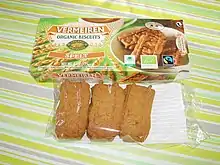Speculoos
Speculoos (French: spéculoos, German: Karamellgebäck) is a biscuit originally manufactured in Belgium, different from Dutch speculaas, in that it does not use the mixture of spices used in speculaas. The main ingredients are wheat flour, candy syrup (from beet sugar), fat, and sometimes cinnamon.

Fewer spices are involved in the process of making Belgian speculoos than in Dutch speculaas, as the spices were much more expensive to import to Belgium than to the Netherlands. Speculoos was developed in the 20th century around the area of Verviers, as an alternative for people who could not afford Dutch speculaas. The origins of speculaas are much older. In the 2020s the names speculaas and speculoos are sometimes used interchangeably in Flanders.[1]
Brands
In Europe, Lotus Speculoos is the most recognized brand. This manufacturer supplied the biscuits individually packaged to the catering industry. In the United States and the United Kingdom, the same company is branded as Lotus Biscoff, short for biscuit with coffee. In October 2020, Lotus Bakeries decided to omit the word "speculoos" from local markets, to harmonise their brand.[2][3] Several chains of supermarkets have started their own product under their generic name. In the US, windmill or almond windmill cookies are mostly based on speculoos.
Spread or paste
Workers in the Low Countries traditionally made a sandwich in the morning with butter and speculaas or speculoos cookies. This took on a spread-like consistency by lunchtime.[4] In 2008, two competitors entered a contest on the Belgian television show, The Inventors (de Bedenkers), with a spread made from speculoos cookies[4][5] — Els Scheppers, who reached the semi-finals, and the team of chef Danny De Mayer and Dirk De Smet, who were not selected as finalists. Spreads made from crushed Speculoos cookies went into production by three separate companies and become popular.
By 2007, several Belgian companies began marketing a speculoos paste, now available worldwide under various brands and names: as Speculla, Cookie Butter, and Biscoff Spread. As a form of spreadable speculoos cookies, the flavor is caramelized and gingerbread-like, with a color similar to peanut butter[6] and a consistency ranging from creamy to granular or crunchy. The spread consists of 60% crushed speculoos cookies and vegetable oils.[6][4] In the United States the grocery chain Trader Joe's sells its own brand of cookie butter and cookie butter ice cream.[6]
See also
References
- Bob Struijcken (February 3, 2021). "Speculaas vs. speculoos. De verschillen tussen speculaas en speculoos". Koekjes Royale (in Dutch). Retrieved May 23, 2021.
- "Lotus zegt vaarwel tegen 'speculoos' en kiest voor internationale naam". Het Laatste Nieuws (in Dutch). October 30, 2020.
- Obdeijn, Laura (2020-11-10). "#jesuisspeculoos strijdt tegen de naamsverandering van Speculoos". Het Parool (in Dutch). Retrieved 2021-12-24.
- Castle, Steven (February 15, 2011). "A Cookie Paste Squeezed in the Middle of a Debate". The New York Times.
- "Belgian's popular bread spread not [sic] longer protected". Wolters Kluwer Law and Business. February 2011. Archived from the original on 2015-06-23. Retrieved 2016-04-08.
- "Speculoos Cookie Butter". Trader Joe's. 2012-04-30. Archived from the original on 31 January 2013.
External links
![]() Media related to Speculoos at Wikimedia Commons
Media related to Speculoos at Wikimedia Commons